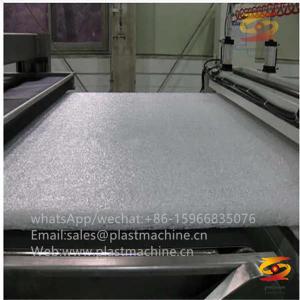Solve the common problems in PVC foam sheet extrusion
Solve the common problems in PVC foam sheet extrusionIn the extrusion process of PVC foamed sheet, the problems encountered can be basically classified into four categories, one is stability problems; the second is melt strength problems; the third is lubrication problems; the fourth is dispersion problems. These four types of problems, especially the first three types of problems, will restrict each other and cross influence. From the surface phenomenon, sometimes the stability is insufficient, which will affect the entire board surface, the board surface is yellow, and the foamed board is brittle.
Insufficient melt strength will lead to large foam cell foam and long longitudinal section. To determine whether the melt strength is insufficient, the most direct way is to press the plate wrapped on the middle roll with your fingers after the three rolls. When the melt strength is good, you can feel the elasticity. If it is difficult to bounce after pressing, it indicates that the melt strength is poor. Because the screw structure and cooling method are quite different, it is difficult to judge whether the temperature is reasonable. Generally speaking, within the allowable load of the extruder, the temperature in zone 3 to 5 is better.
Lubricants are divided into external lubricants and internal lubricants. External lubricants are good for demoulding, which is good for the surface finish of the sheet. The external slip is too little. The temperature in the 5 zone of the extruder is not easy to control and it is easy to heat up, which will lead to confluence. The core temperature is high, large bubbles, stringing, yellowing and other problems occur in the middle of the plate, and the surface of the plate is not smooth; if there is too much slip, the precipitation will become serious. The scale in the mold and the precipitation of the slip on the surface of the plate are also It will show that some individual phenomena move back and forth from time to time on the board. Inner slip is good for plasticization and melt fluidity. Insufficient inner slip is difficult to control the thickness of the board surface, which is shown as the middle thickness of the plate is thin on both sides. If there is too much inner slip, the phenomenon of high temperature of the confluent core is easy to occur. Poor dispersion can cause the surface of the sheet to be non-smooth.
Process temperature control problem: The four problems mentioned above are fundamental problems, they are the foundation and the deep problems. Compared with the above four problems, process temperature control is much more intuitive and is a surface problem, but poor temperature control will induce the emergence of fundamental problems. Increasing the processing temperature, the material stability time will be reduced, and stability problems will occur; the original lubrication balance will be broken, generally manifested as insufficient external lubrication, especially late external lubrication, need to increase the amount of external lubrication added; increased temperature will also lead to When the melt strength is reduced, the foamed sheet has increased cells, the number of cells is reduced, and the sheet is brittle and easy to break; increasing the temperature reduces the melt strength and reduces the melt viscosity. In the case of strong screws, uneven dispersion sometimes occurs.
If you want to know more about it please do not hesitate to contact
me. WhatsApp:+86-15966835076.









